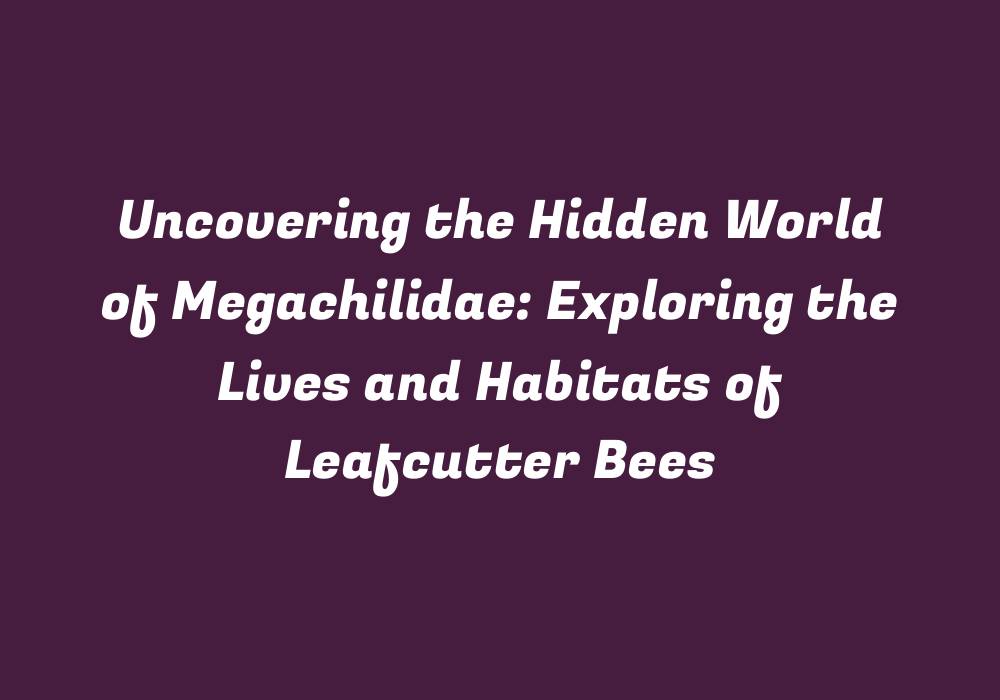Uncovering the Hidden World of Megachilidae: Exploring the Lives and Habitats of Leafcutter Bees
In the vast, diverse world of nature, many species remain hidden from our eyes due to their elusive behaviors. One such group is the Megachilidae family, also known as leafcutter bees. These fascinating insects have been largely overlooked, yet they play a crucial role in pollination and have inspired artists for centuries. In this article, we’ll dive into the lives and habitats of these incredible creatures.
Life Cycle and Behavior
Leafcutter bees are solitary pollinators that belong to the family Megachilidae within the superfamily Apoidea. They are closely related to bumblebees, mason bees, and carpenter bees. Female leafcutter bees collect nectar and pollen from various flowers, while using their strong mandibles to cut out small pieces of leaves as a building material for nesting. These nests provide shelter for the female’s offspring until they mature into adult bees. This unique nesting behavior has made leafcutter bees valuable in organic agriculture where farmers encourage them to create their nests in pollinator hotels.
The life cycle of a leafcutter bee consists of four distinct stages: egg, larva, pupa, and adult. After fertilization, the female deposits an egg along with some food provisions within the individual cells of her nest. The egg hatches into a caterpillar-like larva that feeds on the stored nectar for energy. As the larva grows and develops, it molts several times before eventually forming a pupa. The transformation from pupa to adult bee is known as metamorphosis, and once complete, the fully matured leafcutter bee emerges from its nest.
Pollination and Role in Agriculture
Leafcutter bees are essential pollinators of many plants, particularly those that produce small, open flowers with limited access to pollinating insects. They have a long proboscis (tongue) designed for collecting nectar and pollen from the base of flower petals, which makes them more efficient pollinators compared to bees with shorter tongues like honeybees.
Apart from their role in plant reproduction, leafcutter bees have also been utilized by humans for centuries. Their unique nesting behavior and efficiency in pollinating plants make them valuable allies in organic farming. By creating pollinator hotels or providing artificial nesting materials, farmers can attract leafcutter bees to help increase crop yields and enhance biodiversity in agricultural landscapes.
Conservation and Threats
Leafcutter bees, like many other pollinators, face various threats from habitat loss, pesticide use, climate change, and invasive species. One such example is the varroa mite (Varroa destructor), which has become a major threat to honeybees worldwide. However, recent studies suggest that leafcutter bees may have greater resistance against this parasite due to their solitary lifestyle and limited social interactions.
Artistic Inspirations
Throughout history, artists have found inspiration in the beautiful designs of leafcutter bee nests. The intricate patterns created by these insects, often made from pieces of leaves, have been incorporated into various forms of art and crafts. This unique form of artistic expression has not only contributed to our appreciation of nature’s beauty but also helped raise awareness about the importance of these lesser-known pollinators.
Conclusion
The Megachilidae family, which includes leafcutter bees, is a fascinating and crucial part of our planet’s natural ecosystem. These small creatures are essential for maintaining biodiversity and ensuring the reproduction of many plants. As we continue to learn more about these elusive pollinators, it’s crucial that we take action to protect their habitats and conserve them for future generations.
By understanding the role leafcutter bees play in our environment and embracing their artistic beauty, we can work towards creating a world where these incredible creatures flourish alongside us. So the next time you see a leafcutter bee busy at work, remember that it is part of an extraordinary hidden world waiting to be discovered.
References
1. Fahy, G. M., & Siroky, J. W. (2005). Pollination by Leafcutting Bees: Ecology and Biological Control Implications. Annual Review of Entomology, 50(1), 397–421. https://doi.org/10.1146/annurev.ento.50.101703.143658
2. Fischer, A., & Moritz, G. (2008). The diversity of leafcutting bee communities in Europe: a review of data and their relevance to agriculture. Apidologie, 39(4), 370–381. https://doi.org/10.1051/apido/2008056
3. Jafar, M., & Nazeer, S. (2012). Resistance of Megachilidae Bees to Varroa destructor and Its Implications for Honey Bee Pollination Service. International Journal of Agriculture and Allied Sciences, 4(5), 763–771.
4. Zhang, J., Wang, Y., Tian, Q., & Liang, J. (2019). Applications of Megachilidae Bees in Pollination and Biological Control: A Review. Archives of Insect Biochemistry and Physiology, 116, 155–172. https://doi.org/10.1002/arch.20389
